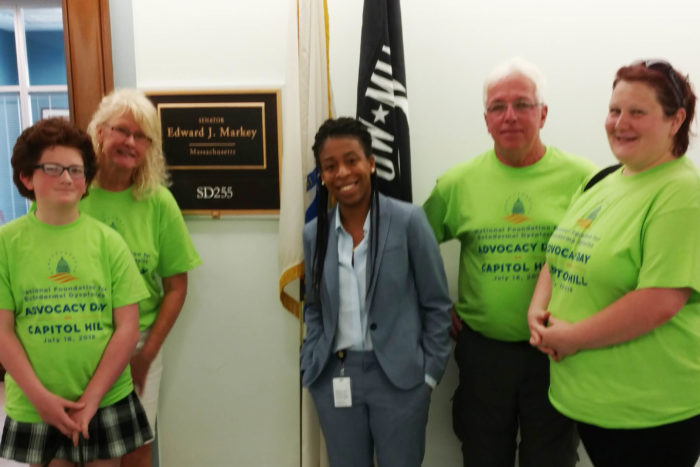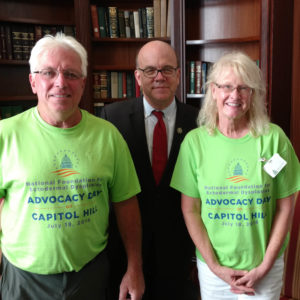My name is Beth Pond and I live in Massachusetts with my husband, Michael, and sons Dylan, Nolan and Philip. I have been a family-driven legislative advocate for 23 years and love every minute of it! I believe there is nothing more powerful than sharing our story and using or voice to make positive change for our children.
Nolan, 24; Philip, 23; and my brother are affected by x-linked hypohidrotic ectodermal dysplasia (XLHED). When Nolan was a year old, I worked with my Massachusetts senator to write a bill that mandated health insurance companies to pay for the medically necessary oral health care for people affected by ectodermal dysplasia.
The boys and I spent years going to the statehouse. Although the bill has not become law, my sons experienced the power of their story and became self-advocates. I am now proud to be part of the National Foundation for Ectodermal Dysplasias’ (NFED) family-driven advocacy efforts and advocate for the Ensuring Lasting Smiles Act (ELSA).
If you haven’t joined us yet, there is no better time than now and there is no need to fly to D.C. to get started. Being an effective family-driven legislative advocate for ELSA does not mean you have to go to Washington D.C. to meet with your Senators or members of Congress. You can visit them at their district offices.
Your members of Congress (United States Senators and Representatives) make time for meetings with constituents as part of their duties as elected officials. Face-to-face meetings are one of the most powerful ways to advocate for ELSA, as a meeting makes you and your issue more memorable to legislators.
It is important to know that the staff who work for members of Congress are very important, too! Whether you meet directly with your senator or representative or with their staff person, you are taking an important step by building a relationship with them.
Here are some steps to get you started.
1. Find the local office that you would like to visit.
U.S. senators and representatives maintain offices in their home states that allow their constituents to meet with them or their staff. If you know who your U.S legislators are, you can go to their website and find information about their local office. If not, you can find that information here.
2. Contact your legislator’s office to set up a meeting.
Find out when the legislator will be back in the district. When the legislature is in session, your senators and representative will be in Washington, DC. When the legislature is in recess, they will likely be back in their local offices. You can check your senators’ and representative’s websites to find out when they are on recess and the nearest office to you.
3. Request a meeting.
Most legislators’ websites include a “Request for Meeting” form that you can fill out online or offer an email address for the person in charge of scheduling their appointments. If you are more comfortable connecting first through email, than you can fill out the form or send an email request for a meeting. If you are sending an email, it should contain your name, address (to show that you are a constituent) a few sentences about ELSA and how you are connected to the legislation.

4. Follow-up.
If you don’t hear back, follow up your request with a phone call to your legislator’s local office a day or two later. Ask for the person in charge of scheduling your lawmaker’s appointments. Write down the date, time and person you spoke with. If the person in charge of scheduling has not called you back in a couple of days, call again. Be polite but persistent!
Recognize that you might meet with a member of your legislator’s staff. Sometimes legislators may not be available and you will be scheduled to meet with a member of their staff. This is still a wonderful opportunity!
Legislators rely heavily on their aides to make decisions as aides are policy experts. Your meeting with a staff member can inform his/her recommendations to your legislator and also build an important relationship with your lawmakers’ district office.
5. Confirm your appointment.
The day before your meeting, call your legislator’s local office to confirm your appointment. Your legislator’s office may request a list of those who will be attending the meeting, if there are attendees other than yourself.
4. Download advocacy resources about ELSA to take with you.
The NFED has sample letters, flyers and other information about ELSA that you can print and take with you to leave behind at the meeting.
5. Follow up with a thank you.
After your meeting, be sure to send a thank-you letter to your lawmaker and/or your lawmaker’s staff. Thank them for taking the time to meet with you and re-iterate the asks that you made in your meeting. Your legislator and their staff will appreciate it and it is a great way to remind them about your requests for ELSA support.
That’s all it takes to become part of this powerful movement. In order for ELSA to increase co-sponsors and gain awareness and support we need families in every state to contact their U.S legislators TODAY.
So what are you waiting for?
Preparefor an Advocacy Meeting
Beth Pond is a guest blogger for the National Foundation for Ectodermal Dysplasias. She is the co-chair of our Family-Driven Legislative Advocacy Committee.
